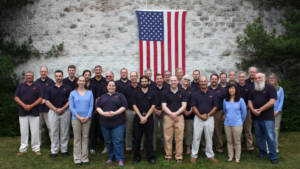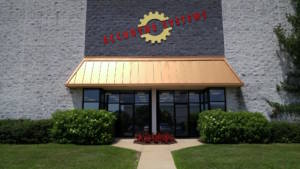Custom Equipment Design & Development Process
As a custom capital equipment manufacturer, Accudyne Systems has significant expertise across several technology areas. Accudyne continues to push the boundaries of each of these mechatronic technology solutions as we advance beyond the ‘State of the Art’ to the ‘State of What is Possible’.
Custom Equipment Design and Development Process
Technology integration and design synthesis are core competencies of Accudyne Systems. Incorporating the appropriate level of technology for the application is important to ensuring that the equipment we build meets or exceeds our customers’ expectations for form, function, cost, and timing. You won’t find a model number on any of our machines as each one is custom designed and built from the anchor lugs up for a specific set of customer requirements. Accudyne builds three main categories of machines (Composites Automation, Supercritical Fluid Processing, and Industrial Automation), and there are process-specific machine types within each of these machine categories. The Accudyne Custom Equipment Design and Development Process is simple, effective, and customer focused:
Concept Development
Accudyne solution developers meet with customers to understand the requirements and assess the scope of project. Conceptual design development begins with a brainstorming session bringing together multidisciplinary ideas from a diverse team of engineers, designers and fabrication personnel. Starting in the preliminary research stage and continuing throughout the project, internal brainstorming sessions are held which involve team members with skills in engineering, software, CAD design, and fabrication so that we thoroughly cover all critical aspects of the project. Our engineers and designers evaluate all of the major systems and components of the proposed solutions to compare performance, availability, compatibility, and pricing. Our in-house research and experimentation facilities are useful for customers who want to prove out a concept in a bench-top experiment before committing to a particular technical solution. In support of Technology Development or Risk Reduction efforts, our own machine, material, and machinist resources are able to create experimental setups quickly. Our machinists are able to make modifications on the fly as emerging data from trials reveals the necessity for changes. The Concept Development phase of the project concludes with a concept review in which a primary design direction is chosen which serves as the seed model for the Preliminary Design Phase.
Preliminary Design
Building on the work in the Concept Development Phase, the Accudyne team begins to aggressively specify integral components of the equipment. This specification process includes researching component configurations and the multiple vendors that supply them. This research consists of distilling information about past experience with a product or vendor, collecting input from others who have experience with the product or vendor, comparing product literature, discussing components with vendor personnel, and/or visiting vendor facilities. Primary component selection criteria are form, fit, function, cost, and lead time. Once components have been selected, the engineers design the main skeleton or equipment framework. The CAD designers then create preliminary 3D models of the mechanical, electrical and pneumatic systems within Autodesk Inventor for further analysis. At this stage of the project, a comprehensive electronic design notebook has been well populated with everything from initial concepts to cut sheets for individual components. In a rigorous design review at the end of this stage (a.k.a. “Preliminary Design Review (PDR), the customer and Accudyne engineers review all aspects of the proposed design. Concerns are quickly and efficiently addressed in this meeting or shortly thereafter to prepare for the detailed design phase.
Detailed Design
Work begins on the Detailed Design immediately following the PDR. This phase flushes out all aspects of the design to fully specify all components in order to populate mechanical, electrical, pneumatic, and/or hydraulic bills of material (BOMs). The 3D CAD models are fully populated with complete details for all fabricated and purchased parts. Electrical CAD drawings provide circuit layouts with all wires labeled and cabinet layouts dimensioned. All purchased parts are fully specified and the pertinent information from BOMs, detailed drawings, and component cut sheets are added to the electronic design notebook. The Detailed Design phase of the project is completed when the Critical (or Final) Design Review (CDR) is complete. At the end of the CDR, or shortly thereafter, the customer provides approval for manufacture of the equipment which begins with Procurement and Fabrication.
Procurement and Fabrication
Once design approval is provided following the CDR, support staff and engineers get busy writing Purchase Orders (POs) and assembling Fabrication BOM’s. Accudyne has internal mechanical and electrical fabrication shops that are well versed in all manner of manufacturing techniques. Although we do use external machine shop resources when as required, having in-house fabrication facilities and personnel enables us to monitor quality and control delivery schedule closely. Our technicians and machinists are able to fabricate parts that cannot be cost effectively purchased from commercial vendors. Accudyne can fabricate all non-commercial items including hydraulic, pneumatic, electrical and mechanical assemblies in its in-house manufacturing facility.
Assembly
Fabricated and procured components are collected in the flexible manufacturing and assembly area of our facility until they are ready for assembly. The BOM’s are used to track component fabrication and procurement to ensure that all components are acquired and organized in the receiving area. Technicians have direct access to Engineers, and Designers for the equipment should any assembly issues arise that require quick resolution. As technicians wire, place, and secure each component and install safety guards to protect operators, the engineers make sure that equipment assembly proceeds according to the assembly drawings of the approved design and that the equipment meets the form, fit, and function of the design. Any changes or modifications are red-lined onto the master set of drawings.
Startup
To ensure that the equipment we build meets or exceeds customer expectations, Accudyne accomplishes equipment startup and runs every piece of equipment before it is delivered to the customer. This Factory Acceptance Testing (FAT) is critical to ensure successful commissioning of the equipment in the customer’s site. Our mechanical engineers make sure that all mechanical and pneumatic systems are functioning properly. Electrical engineers align all sensors and test all electrical systems. Our software engineers extensively test the operator interface, safety interlocks, and production programs. Once the FAT is complete, the equipment is crated and shipped to the customer site.
Installation, Training, & Support
Accudyne arranges for transport of the equipment to its new home, uncrates it, re-assembles it as necessary, integrates it with the existing customer equipment, and tests it again [Site Acceptance Testing (SAT)] to provide verification of proper performance. We provide onsite operator training for routine equipment usage and, if desired, we can also provide in-depth training on diagnostics, maintenance, and programming for advanced operators/engineers and equipment maintenance specialists. An operator’s manual is provided detailing safety procedures, troubleshooting, routine operating instructions, and maintenance. Since our machines are often unique, first-of- a-kind, and/or groundbreaking, issues may arise after machine commissioning. When support is required, Accudyne will be there to troubleshoot, make repairs, and get you back on track. Our engineers also provide telephone or onsite technical support as required.
Our Mission
Incorporating the appropriate level of technology for the application is important to ensuring that the equipment we build meets or exceeds our customers’ expectations for form, function, cost, and timing.
Our Facility
Accudyne’s in-house engineering and design center ensures confidentiality, maintains control of schedule and costs, and most importantly, fosters interaction between designers, engineers, and technicians.


